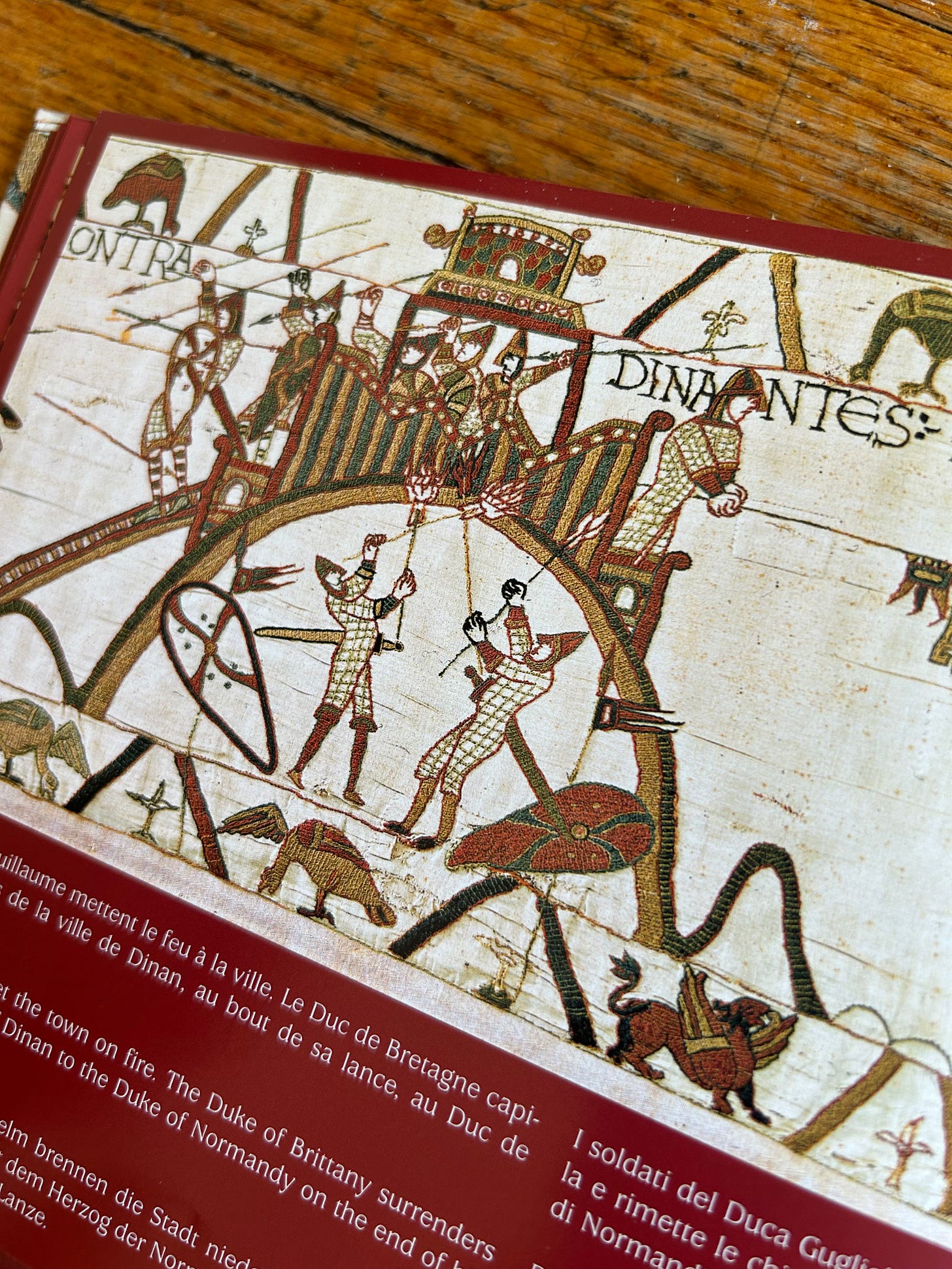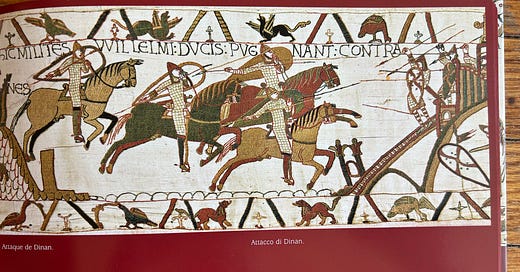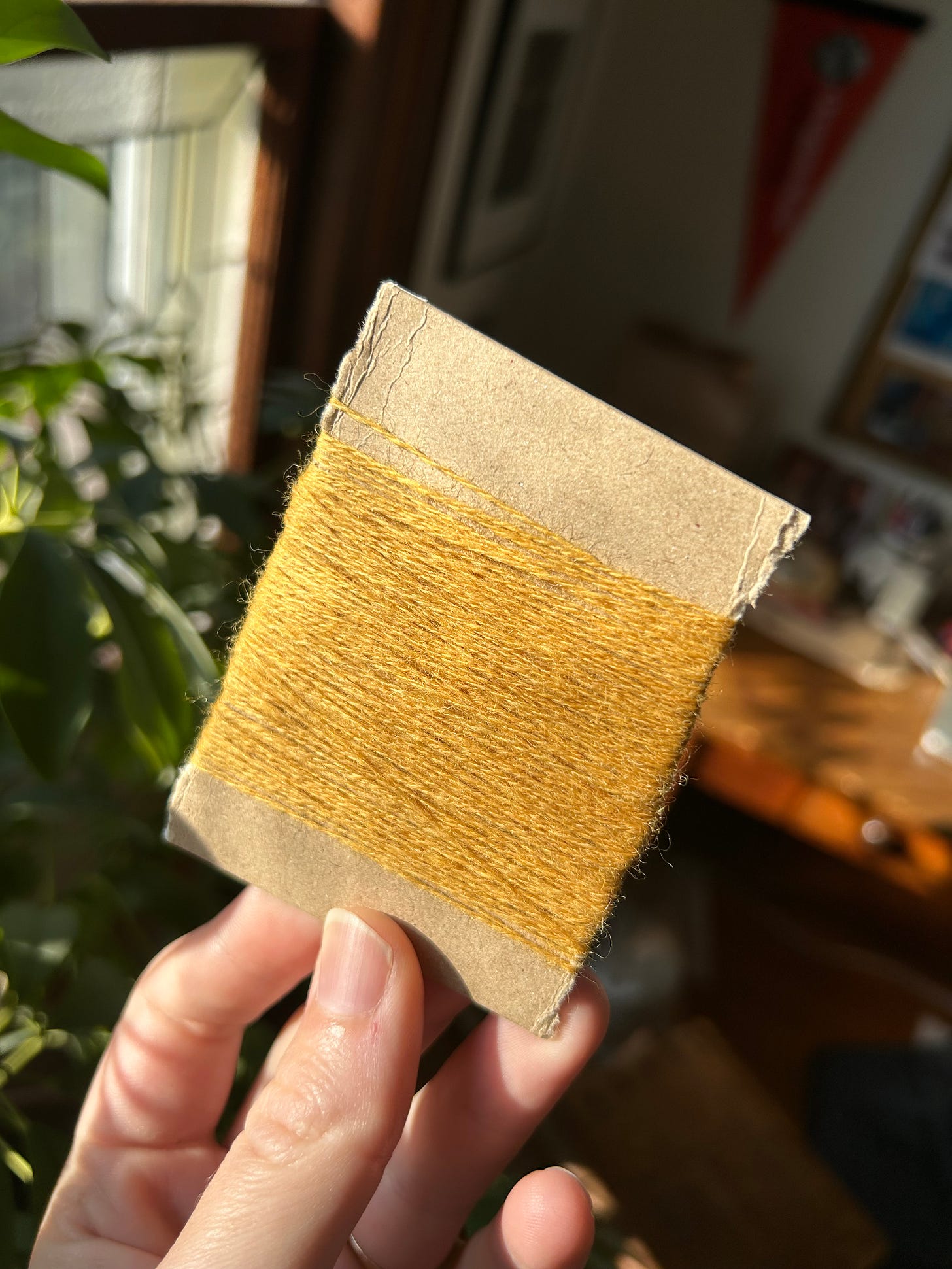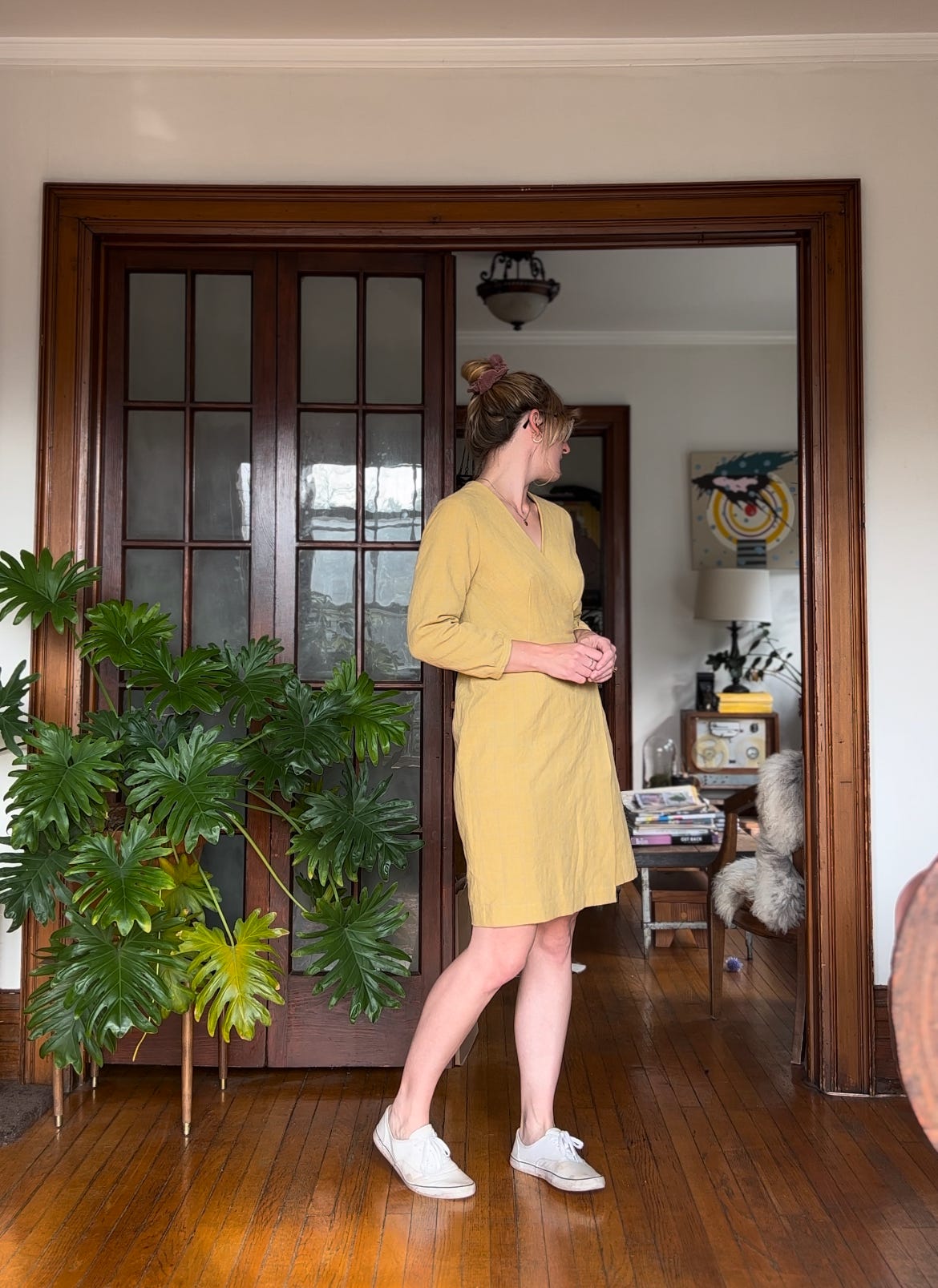Working On: studying the embroidery of the Bayeux Tapestry
One of my favorite works of art, ever.
When the Bayeux Tapestry was created in the late 11th century, it was necessary not only to conceive the embroidery design and then execute it in wool thread, but also to custom-make the materials that were used. As the Tapestry measures 20 inches wide by about 220 feet long, this would have been a significant undertaking. Not only did the linen fabric have to be made (the flax being both hand-spun and then hand-woven), but ten colors of wool worsted had to be dyed and spun, according to the schematic decided upon by the designer(s). This would have required around a hundred pounds of wool which, as was the tradition at the time, would have been dyed ‘in the fleece’, prior to being spun, so as to achieve a greater depth of color and more consistency across the whole of the thread.
The dyers - those mysterious alchemists, relegated to the outskirts of towns due to the stench of their craft - would have used three plants, weld, woad, and madder, in various combinations and with an alum mordant, to achieve these colors. And according to Carola Hicks’ The Bayeux Tapestry: The Life Story of a Masterpiece, from which all of this information is drawn, the dyers accomplished this so effectively that the plant-dyed, 11th-century wool has held up better, with less fading and less moth damage, than the chemically-dyed thread that was used to make repairs on the tapestry in the 19th century.
After the fiber was dyed, it would have been spun (and, presumably, plied - though I can’t find any information on the actual structure of the thread) using a drop spindle, before being hand-stitched onto the linen by the women in the embroidery workshop. All of this must have taken a very long time. It’s hard to know for certain, but an 1886 replica of the Tapestry, which had the advantage of using purchased linen fabric and machine-spun wool thread, was stitched by 37 women and took more than a year to complete.

The Bayeux Tapestry is the earliest example we have of crewel embroidery; that is, embroidery done with wool thread on a linen fabric. I have seen the Tapestry once, four years ago, and I don’t think I’ve ever been so enchanted by a piece of art before. The embroidery itself is unusual, as it is mostly worked in a rippling couching stitch that is actually called Bayeux stitch. It has an incredible texture, and makes the Tapestry almost three-dimensional, as the thread rises up off the fabric towards you.
We do not know for certain who designed the the Bayeux Tapestry, and we certainly don't know the women who stitched it. Most scholars agree that they were English, and they were probably professionals - that is, they were employed in an embroidery workshop, earning a wage for their work. The head of the workshop might have created the design, or perhaps it was given to them by an artist who had been hired by the commissioner of the Tapestry. The embroiderers expressed their individuality within the design of the Tapestry, stitching the foliage and diagonal lines of the border sections according to their own style. I like to think about them stitching, feeling the importance of their work, putting in a small artistic flourish for their own sake.

Is the Bayeux Tapestry art? Or is it just a functional object, created simply to illustrate a story, to promote the idea of William the Conqueror's legitimacy and Harold's treachery? Anni Albers famously discussed the interconnections between art and design when she said, of weaving: "Usefulness does not prevent a thing, anything, from being art. It is the thoughtfulness, care, and sensitivity in regard to form that makes a house or a fabric turn into art and it is this degree of thoughtfulness, care, and sensitivity that we should try to achieve."
Was Art even an idea that the makers of the Tapestry would have understood, in the way that we conceptualize it now?
I have taken up embroidery recently, too. As a nine-year-old, I was a serious cross-stitcher, and I do decorative embroidery occasionally (mostly when I make historical costumes for my little sister), but I feel that this is a real step in a new direction. With this work, I want to express some of the strangeness of being a human right now; the difficulty of formulating a cohesive sense of self in a world where it feels like someone is always watching; the impossibility of representing yourself the way that you would like to be seen. I see this as an extension of my making practice, which is mostly focused on creating clothing that I hope will make me feel more like myself. All of it is an exploration of the human experience, an attempt to make sense of life as it is lived now.
One of the things I have decided to do, in the execution of this work, is to spin my own embroidery thread. It certainly adds time to the process but it also adds an additional degree of control and expressiveness. Currently I am spinning a golden thread on my Turkish spindle, from Bluefaced Leicester fiber that I dyed myself, with onion skins. I am planning to dye more fiber, with apple bark, to spin into thread for a piece I've just begun to conceptualize. There is something about consciously going back to historic methods that I've always enjoyed, and I find it a little subversive, too. It feels like a rejection of some of the modern values I don't believe in - concepts like high-speed manufacturing, overproduction, overconsumption. I like being able to opt out in this way, expressing my dissatisfaction with late-stage capitalism by going back to a tenth-century method of material production.
Every time I look at the Bayeux Tapestry, I find something new to admire. Not only is it a compelling, humorous narrative tale (sometimes I think of it as the first graphic novel), the work itself is stunning. Every scene is carefully made and intricately detailed. As a maker and craftsperson, I find it inspiring on every level. With my own work, I want to put as much thought and care into everything I make as the creators of the Tapestry did.
Last weekend, I finished sewing this wrap dress, made in a truly glorious Merchant and Mills windowpane-check linen. Today, I wrote a little bit on Instagram about my desire to sew clothing that is adjustable in size - to make garments that will adapt to my body. I find it difficult to commit to sewing a highly-fitted piece that won’t fit if I eat a little more at dinner, so I’ve been turning to patterns that wrap, tie, or cinch in with drawstrings, to add that little extra bit of flexibility. The pattern I used here is McCalls 6959 and I highly recommend it, even for beginners - it’s easy, quick, and (more importantly) fun to sew.
This weekend I plan to sew another pair of Peppermint Wide Leg Pants (adding belt-loops this time!) and cast on a sweater. All of the materials I’ll use came from stash, though in a moment of weakness yesterday I purchased two remnants of bottom-weight fabric from Swanson’s, a secondhand fabric store that sells online in addition to their storefront in Massachusetts. As a longtime buyer of thrifted fabric, I was really excited to learn about this store - they have some amazing stuff and it’s so great to be able to buy secondhand material and give it a new life in a project.
Well, that’s all from me this week - I hope you all have a fabulous, fun-filled weekend. If you enjoyed this edition of the newsletter, please subscribe if you haven’t already, and feel free to share with a friend or on social media. Talk to you soon!









Oh, wow! Yes, Bayeux is so lovely - I really fell in love with the town. I also feel lucky because we visited the tapestry before the school holidays, and were pretty much the only people in there! I’m glad you made it to the correct beach eventually; we visited Omaha Beach on the same trip and it was extremely moving.
I loved everything about today's letter. I started collecting women's handwork when I was in my 30s (1970s): handkerchiefs, table runners, embroidered pillowcases and tea towels, and quilts. Eventually I stopped collecting and started distributing my finds to others who cared. I'm happy to know you are keeping these arts alive. That tapestry sounds amazing. Every detail. I have a piece my friend Kate designed and embroidered for me on navy blue silk, it depicts a dream I had and told her about. It hangs above my bed and has for forty-five years. My home is filled with women's art, including paintings by my granddaughter and daughter. I kept the quilt made by my paternal grandmother for her own wedding in the 1800s. She hand pieced and hand quilted. It is worn and faded, but still loved. Your own works will live on, and I hope be appreciated and loved as they should be.